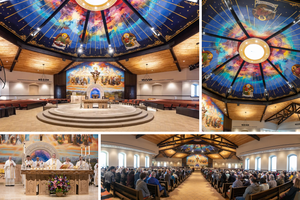Catholic Convert Jesse Straight — ‘Farming in Line with Biology’
“The life of holiness and the love of God and neighbor to help us aspire to benefit all we come in contact with — the land, our animals, and the people who eat our foods.”

Perhaps one of the best-known farmers in northern Virginia is easygoing Jesse Straight of Whiffletree Farm in Warrenton. Straight, with his Catholic wife and family, has created something of a rural paradise on their 80 acres, where herds of pigs and cattle and flocks of chickens and turkeys thrive, and streams of visitors stop by to view the land and to pick up produce and farm products from their onsite store.
As it turned out, converting to Catholicism changed Straight’s life in unforeseen ways, turning him away from premed studies to operating a farm, which he and his family use to praise God by raising stock to feed others. Straight must truly believe that God brought him here for a purpose. As he has stated, he has learned the link between farming and what God intended for the earth. “God has made the world in a particular way,” he said. “We try to work in line with creation’s logic and systems — farming in line with biology, not against it.”
The past three years in particular have altered his farming approach. He has not only hired really terrific farming staff, he has also learning to run a more organized business by training staff, incorporating working protocols, planning in advance and systemizing ways to communicate. While he has not quite reached all these goals, he said, he and his staff have a priority to work on achieving them.
And farming has been another way to fulfill his dream. “I have dreamt of becoming a sustainable pasture-based farmer with my family joining me,” he said. “It was a longshot because I am not from a farm family, and I had to learn two things at once — running a business and being a farmer.”
In addition, he wanted to raise animals in a way “most fitting to nature as God’s order and with transparency and with kindness,” he said. “I want to make animals and staff happy. I hope to have the healthiest chickens in Virginia, and I also want the happiest employees and interns. That is part of community life.” To underscore that, Straight brings staff together several mornings a week for a team breakfast, and that helps people get excited about new friendships.
Of course, Catholic Straight has asked priests from his local parish in Warrenton, St. John the Evangelist, to bless the property. That included former pastor Father Mark Moretti to bless the house and farm. “In terms of these blessings,” said Straight, “it is pretty fundamental: the life of holiness and the love of God and neighbor to help us aspire to benefit all we come in contact with — the land, our animals, and the people who eat our foods.”
Many parishioners have also been Whiffletree Farm customers, he added, particularly when Father Moretti was the local pastor; they used to bring him foods he liked. He had a special passion for his bacon and some organic products from the store.
The current pastor, Father Charles Smith, and his parishioners also visit the farm … and what a blessing for all to find locally raised chickens, pork, beef, turkeys and eggs, and to shop at the store that sells baked goods, produce and honey.
Whiffletree Farm, 8717 Springs Road, Warrenton, Virginia — http://www.whiffletreefarmva.com.
* * * * * * *
Recipe: The Best Steak, Cooked Indoors
[From Long Way on a Little, by Shannon Hayes]
- 1 to 2 tablespoons coarse salt
- 2 to 3 teaspoons ground black pepper
- 1 to 2 cloves garlic, minced
- 2 tablespoons butter, tallow or rendered lamb fat
About 1 ¼ to 2 pound of sirloin, sirloin tri-tip, top round or London broil steak; OR 2 shoulder top blade, shoulder petite tender, rib, porterhouse, T-bone, top loin (New York strip), or tenderloin (filet mignon) steaks, cut 1¼ to 1½ inches thick.
Combine the salt, pepper and garlic in a small bowl. Rub the mixture into both sides of the steak, then allow the meat to come to room temperature.
Preheat the oven to 200 F, then heat a large cast-iron or other ovenproof skillet over a high flame. Once the skillet is so hot that you can see a little smoke rising off it, add the butter and/or fat and sear the steak for 2 minutes on each side.
Turn off the flame and insert an ovenproof meat thermometer into a boneless side of the steak (do not insert it into the top, as there is not enough depth for the thermometer to take an accurate reading). Leaving the steaks in the skillet, place them in the oven and allow them to finish cooking, about 10-20 minutes, until the internal temperature reads 115-135 degrees. Remove the steaks and allow them to rest 5 minutes before carving and serving. The temperature will rise a few more degrees during this time.
*These are not USDA’s recommended temperatures. Please see Shannon Hayes’ Long Way on a Little for explanation on why she recommends these lower temperatures for grass-fed meat.
- Keywords:
- farming

















